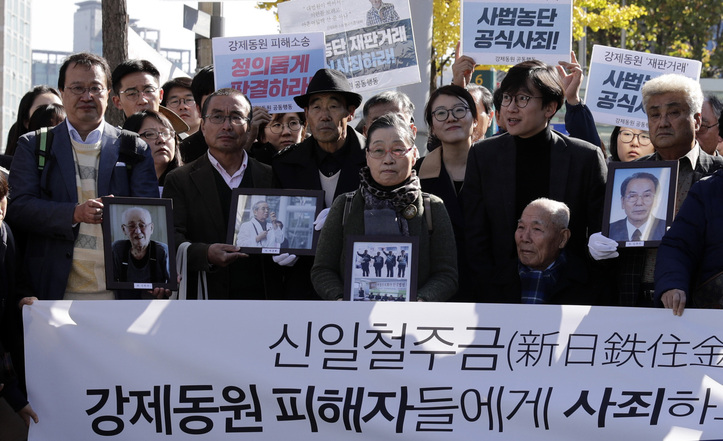 |
|
Forced labor victims in front of the South Korean Supreme Court after its ruling that Japanese companies are obliged to compensate victims on Oct. 30, 2018. (Kim Myoung-jin, staff photographer)
|
How far is the South Korea-Japan dispute over forced labor going to go?
The dispute between South Korea and Japan over compensation for Koreans forcibly conscripted into labor during Japan’s colonial occupation of the Korean peninsula is turning into a game of chicken, with neither side willing to show itself as a coward. In a ruling in October 2018, South Korea’s Supreme Court ordered Japanese companies such as Nippon Steel & Sumitomo Metal and Mitsubishi to compensate the victims of forced labor, but the Japanese government has instructed these companies not to do so, on the grounds that the issue was resolved by a 1965 agreement settling the right to make claims. Legal representatives of the forced labor victims say that they’re planning to liquidate the assets seized from Japanese companies in South Korea if compensation is not provided. But the Japanese government has publicly threatened to retaliate if the asset sale goes ahead. Some analysts think that Japan is unlikely to actually impose retaliatory tariffs or other sanctions because they would harm Japan as well, but the Japanese administration under Prime Minister Shinzo Abe is unlikely to just sit on its hands. This is a perilous situation in which Japanese sanctions are sure to provoke a response from South Korea, which could lead to an unprecedented economic war between the two countries. Cold War forced South Korea and Japan to remain on civil terms South Korea and Japan’s dispute over historical issues has been raging for a long time. But the reason that the friction is particularly intense at this particular point in time has to do with the changing political landscape in the two countries. During the Cold War, a stable relationship between South Korea and Japan was important to both countries, as well as the US: South Korea needed Japan’s capital and technology for economic development; Japan regarded the Korean Peninsula as a lifeline for security; and the US wanted to establish the two countries as an anti-communist bastion in East Asia. Consequently, they were compelled to keep their historical dispute to a level that wouldn’t damage their overall relationship. That situation has changed since the 1990s through a combination of factors, including the dissolution of the Cold War alignment, the advance of democratization in South Korea and the shrinking gap between South Korean and Japanese economies. This has led to an eruption of demands for digging into historical issues and compensating victims, which had been previously suppressed. Buoyed by a tendency for Japan to shift to the right, the Abe administration has adopted a hardline response that is pushing the historical dispute to an extreme. While there have been efforts to manage South Korea-Japan relations within the framework of trilateral security cooperation with the US after the North Korean nuclear threat arose in the mid-1990s, even those have lost steam during the recent shift toward dialogue on the Korean Peninsula. It goes without saying that a diplomatic solution – whether that be a temporary expedient or something more permanent – will be necessary to prevent the issue of compensation for forced labor victims from wrecking bilateral relations. But that won’t be easy under the current circumstances. Diplomats from both sides recently met for working-level deliberations, but all they managed to do was reaffirm their differences. Abe administration’s negative impact on negotiations The Abe administration has declared itself unwilling to compromise, characterizing this as an issue that the South Korean government must resolve on its own. During the lawsuit, Mitsubishi initially adopted a relatively flexible stance. It had held 10 rounds of talks with the victims of forced labor and even offered to consider setting up a scholarship fund for the family members of victims, though it drew a line at directly compensating the victims. But after the Japanese government gave instructions to refrain from compensation or reconciliation after the South Korean Supreme Court’s ruling on compensation, the company has changed its position and refused to respond to any requests for further talks. The South Korean government, under President Moon Jae-in, has not been very eager to find a diplomatic solution, either. To be sure, that attitude is not wholly unreasonable. Since the compensation ruling was the decision of South Korea’s judicial branch, the fact is that the administration, as the executive branch, has little say, given the division of government powers. There are also historical lessons at play here. The 1965 agreement about the right to make claims and the 2015 comfort women agreement were attempts to resolve issues of the past through diplomacy. But those diplomatic compromises failed to resolve conflict because they disregarded the victims, and they eventually only fueled more conflict. That leaves the government with no choice but to be cautious about hasty diplomatic compromises. S. Korean government has no choice but to take action But the government would be remiss in its duties to take no action at all. At the present moment, the heavy burden of the fate of South Korea-Japan relations is fully resting on the shoulders of the victims of forced labor. In order for them to receive compensation, they have to move ahead with liquidating the assets confiscated from Japanese companies, but that would likely provoke Japan into taking retaliatory measures and could escalate into an all-out clash between the two countries. That’s more than the victims of forced labor can personally bear.
 |
|
Park Byong-su, editorial writer
|







